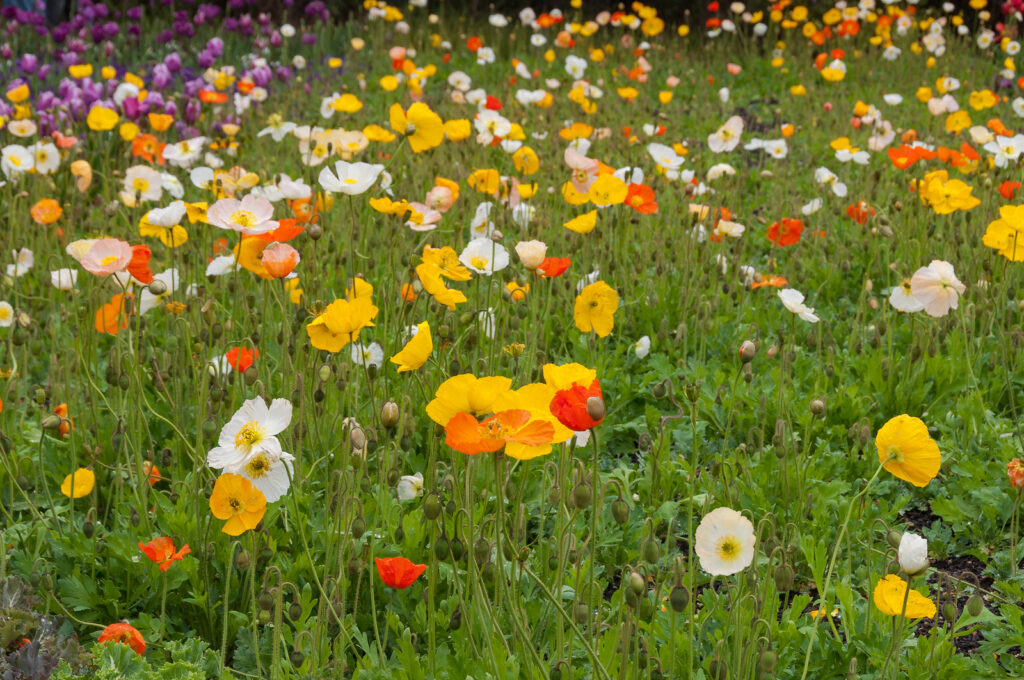Oriental Poppy, Papaver oriental, produces solitary saucer-shaped blooms in summer. The flowering season is short but colorful. The
Good Products for Garden Care at Amazon:
- Garden Safe Snail and Slug Bait
- Bonide Sulfur Fungicide
- Monterey BT Caterpillar Killer
- Neem Bliss 100-% Cold Pressed Neem Oil
- Safer Brand Insect Killing Soap
- PyGanic Botanical Insecticide
The Oriental poppy is an upright perennial with divided mid-green leaves.
Oriental poppies are spectacular additions to mixed borders, cottage, and meadow gardens.

Get to know Oriental poppy–Papaver
- Plant type: Perennial
- Growing Zones and range: 3-9
- Hardiness: Hardy to -40°F (-40°C)
- Height and width: 24 to 36 inches (61-91cM) tall and wide
- Foliage: Simple and toothed or pinnate leaves are bristly or smooth and gray-green or light to dark green
- Flowers: Bowl-shaped crepe-papery blooms up to 8 inches across
- Flower colors: Rich hues of orange, red, pink, and white with black centers
- Bloom time: Late spring and early summer
- Uses: Mixed flower borders, cottage garden
- Garden companions: peonies, bearded iris, baby’s breath, cosmos, sunflowers, African marigolds
- Common name: Oriental Poppy
- Botanical name: Papaver orientale
- Family: Papaveraceae
- Origin: Europe to East Asia and in Western North America
Where to plant Oriental poppy–Papaver
- Plant oriental poppies in full sun in cool-summer areas and in Zones 2-6; plant in partial shade in warm areas in Zones 7-9.
- Grow oriental poppies in humus-rich, average, well-drained soil.
Oriental poppy–Papaver uses and companions
- Use oriental poppies in a mixed or herbaceous border.
- Use oriental poppies in cottage gardens and informal plantings.
- Good companions for oriental poppies include Achillea, Artemisia, Coreopsis, Euphorbia corollata, Gypsophila paniculata, Iris, Verbena rigida.

When to plant Oriental poppy–Papaver
- Set oriental poppies into the garden in spring when the danger of frost has passed.
Planting and spacing Oriental poppy–Papaver
- Space oriental poppies 2 to 3 feet apart.
How to Water and Feed Oriental Poppy–Papaver
- Oriental poppies need moderate water; keep the soil evenly moist. Oriental poppies are somewhat drought-tolerant.
- Fertilize oriental poppies occasionally with an all-purpose fertilizer or work a slow-release fertilizer into the soil in spring.
Oriental poppy–Papaver care
- Mulch around oriental poppies to conserve soil moisture.
- Remove faded flowers unless you want to harvest seedpods.
- Keep faded flowers picked to prolong blooms.
- Oriental poppies lose their foliage in midsummer; the foliage will reappear in autumn. Fill the blank spots in the garden with other annuals until the oriental poppies reappear.
- Avoid overwatering; roots that are too wet can rot or become diseased.
Oriental poppy–Papaver pests and diseases
- Powdery mildew, leaf smut, gray mold, root rot, and damping off can occur.

Oriental poppy–Papaver propagation
- Oriental poppy seeds germinate in 14 days at 55°F (13°C).
- Sow seed in the garden in spring for annuals and biennials.
- Sow perennials in containers in autumn or spring.
- Divide perennials in spring or take root cuttings in late autumn or early winter.
Oriental poppy–Papaver varieties to grow
- Papaver orientale, Oriental poppy: clump-forming perennial, spreading by runners; has erect, white-bristly stems, and mid-green leaves that are lance-shaped and toothed; bears solitary, cup-shaped orange-scarlet flowers 4 to 6 inches across; petals have large bluish black or white basal spots. Cultivars include:
- ‘Allegro’ has bright orange-scarlet flowers with black basal marks.
- ‘Beauty of Livermere’ has crimson-scarlet flowers.
- ‘Black and White’ bears white flowers with crimson-black marks at the base of each petal.
- ‘Carnival’ has frilled petals, white at the base and orange-red above.
- ‘Helen Elizabeth’ bears salmon-pink flowers.
- ‘Indian Chief’ has mahogany-red flowers with no spots.
- ‘Maiden’s Blush’ has ruffled white flowers.
- ‘May Queen’ had double orange-red flowers with slight quilled petals.
- ‘Mrs. Perry’ has pale salmon-pink flowers.
- ‘Perry’s White’ has white flowers with maroon-purple centers.
- ‘Picotee’ has white flowers with orange-pink margins.
- ‘Pinnacle’ has bicolored white and scarlet flowers.
- ‘Prince of Orange’ has orange-scarlet flowers.
- ‘Princess Victoria Louise’ bears salmon-pink flowers with a black basal blotch on each petal.
Oriental poppy frequently asked questions
Q: I see Oriental poppies growing where I didn’t sow seeds. What’s happening?
A: Oriental poppies reseed themselves and plant voluntarily come the following spring. Sometimes seeds fall where they haven’t been sown.
Q: When is the best time to sow poppy seeds?
A: Poppy seeds can be sown in the fall for germination and growth the following spring. The seeds should be covered; they require darkness to germinate.
Q: Can I start poppy seeds indoors in spring?
A: Poppy seeds will have a difficult time germinating indoors. They require cool temperatures to germinate. They also do not like to be transplanted.
Q: How can I make poppies bloom last through the season?
A: Poppies do not have a long blooming period. Sow seeds every two weeks during spring and early summer for continual flowering. They will not do well in hot weather. Do not overwater poppies.



